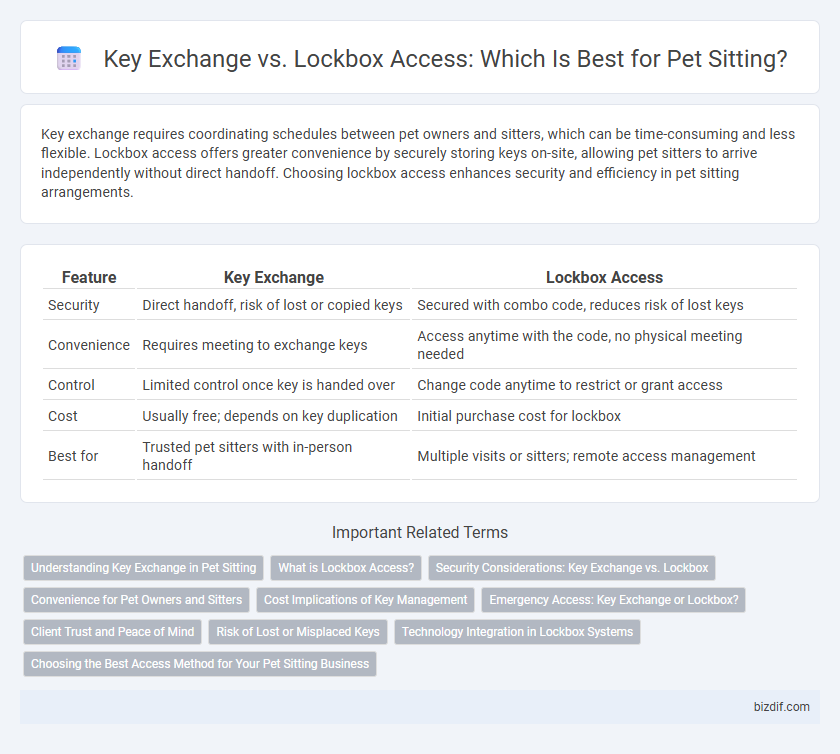Key exchange requires coordinating schedules between pet owners and sitters, which can be time-consuming and less flexible. Lockbox access offers greater convenience by securely storing keys on-site, allowing pet sitters to arrive independently without direct handoff. Choosing lockbox access enhances security and efficiency in pet sitting arrangements.
Table of Comparison
| Feature | Key Exchange | Lockbox Access |
|---|---|---|
| Security | Direct handoff, risk of lost or copied keys | Secured with combo code, reduces risk of lost keys |
| Convenience | Requires meeting to exchange keys | Access anytime with the code, no physical meeting needed |
| Control | Limited control once key is handed over | Change code anytime to restrict or grant access |
| Cost | Usually free; depends on key duplication | Initial purchase cost for lockbox |
| Best for | Trusted pet sitters with in-person handoff | Multiple visits or sitters; remote access management |
Understanding Key Exchange in Pet Sitting
Key exchange in pet sitting involves a direct handoff of keys between the pet owner and sitter, ensuring secure and personalized access tailored to the pet's routine. This method allows sitters to receive explicit instructions and build trust, minimizing risks associated with unauthorized entry. Unlike lockbox access, key exchange emphasizes face-to-face interaction and accountability, enhancing the safety and comfort of both pets and owners.
What is Lockbox Access?
Lockbox access allows pet sitters to retrieve house keys from a secure, tamper-proof box located on the property, enhancing convenience and security. This method eliminates the need for in-person key handoffs, providing flexible scheduling and peace of mind for pet owners. Lockboxes with combination codes or electronic access offer controlled entry while minimizing the risk of lost or duplicated keys.
Security Considerations: Key Exchange vs. Lockbox
Key exchange for pet sitting involves direct handover of physical keys, which can risk lost or copied keys compromising home security. Lockbox access offers a secured, coded entry system minimizing physical key handling and enabling controlled, temporary access codes. Choosing lockboxes enhances security by reducing unauthorized access and enabling real-time access monitoring for pet sitters.
Convenience for Pet Owners and Sitters
Key exchange offers pet owners and sitters personalized interaction, ensuring direct handoff and immediate communication, which enhances trust and clarity. Lockbox access provides round-the-clock convenience by allowing sitters to retrieve keys anytime without coordinating schedules, minimizing disruptions for busy pet owners. Both methods streamline pet care logistics, but lockbox access maximizes flexibility, while key exchange fosters direct rapport.
Cost Implications of Key Management
Key exchange involves direct handover of keys between pet sitters and pet owners, often requiring in-person meetings that increase time and transportation costs. Lockbox access reduces expenses by enabling multiple sitters to use a single secured key storage, minimizing scheduling conflicts and travel. Investing in a lockbox can lead to long-term savings despite the initial purchase expense, enhancing convenience and operational efficiency in pet sitting services.
Emergency Access: Key Exchange or Lockbox?
Emergency access in pet sitting is crucial, with key exchange providing immediate, direct entry by handing over physical keys, ensuring quick response times during urgent situations. Lockbox access offers a secure alternative where keys are stored in a combination-protected box, allowing trusted pet sitters timely entry without the owner's physical presence. Choosing between key exchange and lockbox access depends on balancing convenience, security, and rapid emergency response needs during pet care.
Client Trust and Peace of Mind
Key exchange offers personalized trust-building through direct interaction, allowing clients to feel assured by meeting the sitter in person and verifying identities. Lockbox access provides enhanced security and convenience, enabling clients to securely store keys with controlled access codes, reducing the risk of lost keys and unauthorized entry. Both methods prioritize client peace of mind by balancing safety, ease of use, and reliable access during pet sitting services.
Risk of Lost or Misplaced Keys
Key exchange for pet sitting involves handing over physical keys, which carries a significant risk of being lost or misplaced, potentially compromising home security. Lockbox access eliminates this risk by securely storing keys in a coded container, reducing the chance of keys being lost while ensuring controlled entry. Pet sitters benefit from consistent, safe access without the stress of managing physical keys directly.
Technology Integration in Lockbox Systems
Lockbox systems integrate advanced technology such as Bluetooth, NFC, and mobile app controls to enable secure, time-sensitive key access for pet sitters without physical handoffs. These systems offer real-time access tracking, encrypted digital entry codes, and remote management, enhancing security and convenience compared to traditional key exchanges. Technology-driven lockboxes reduce the risk of lost keys and simplify coordination by providing pet owners with flexible access controls and audit trails.
Choosing the Best Access Method for Your Pet Sitting Business
Choosing the best access method for your pet sitting business involves weighing the security and convenience of key exchange against the flexibility of lockbox access. Key exchange allows direct control over who has access but requires in-person meetings, potentially increasing time commitments and risks of lost keys. Lockbox access offers 24/7 availability with secure code entry, reducing logistical challenges while maintaining client trust through encrypted lockbox systems tailored for pet care professionals.
Key exchange vs Lockbox access Infographic

 bizdif.com
bizdif.com